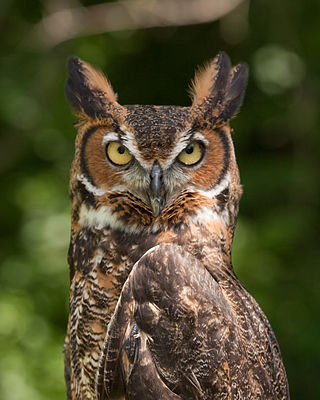
A poppy is a flowering plant in the subfamily Papaveroideae of the family Papaveraceae. Poppies are herbaceous plants, often grown for their colourful flowers. One species of poppy, Papaver somniferum, is the source of the narcotic drug mixture opium which contains powerful medicinal alkaloids such as morphine and has been used since ancient times as an analgesic and narcotic medicinal and recreational drug. It also produces edible seeds. Following the trench warfare in the poppy fields of Flanders, Belgium during World War I, poppies have become a symbol of remembrance of soldiers who have died during wartime, especially in the UK, Canada, Australia, New Zealand and other Commonwealth realms.

The horned lark or shore lark is a species of lark in the family Alaudidae found across the northern hemisphere. It is known as "horned lark" in North America and "shore lark" in Europe.

Phrynosoma, whose members are known as the horned lizards, horny toads, or horntoads, is a genus of North American lizards and the type genus of the family Phrynosomatidae. Their common names refer directly to their horns or to their flattened, rounded bodies, and blunt snouts.

The great horned owl, also known as the tiger owl, or the hoot owl, is a large owl native to the Americas. It is an extremely adaptable bird with a vast range and is the most widely distributed true owl in the Americas. Its primary diet is rabbits and hares, rats and mice, and voles, although it freely hunts any animal it can overtake, including rodents and other small mammals, larger mid-sized mammals, birds, reptiles, amphibians, and invertebrates. In ornithological study, the great horned owl is often compared to the Eurasian eagle-owl, a closely related species, which despite the latter's notably larger size, occupies the same ecological niche in Eurasia, and the red-tailed hawk, with which it often shares similar habitat, prey, and nesting habits by day, thus is something of a diurnal ecological equivalent. The great horned owl is one of the earliest nesting birds in North America, often laying eggs weeks or even months before other raptorial birds.

The Greater Short-Horned Lizard, also commonly known as the Mountain Short-Horned Lizard, is a species of lizard endemic to western North America. Like other horned lizards, it is often called a "horned toad" or "horny toad", but it is not a toad at all. It is a reptile, not an amphibian. It is one of seven native species of lizards in Canada.

The horned screamer is a member of a small family of birds, the Anhimidae, which occurs in wetlands of tropical South America. There are three screamer species, the other two being the southern screamer and the northern screamer in the genus Chauna. They are related to the ducks, geese and swans, which are in the family Anatidae, but have bills looking more like those of game birds.

The four-horned antelope, or chousingha, is a small antelope found in India and Nepal. Its four horns distinguish it from most other bovids, which have two horns. The sole member of the genus Tetracerus, the species was first described by French zoologist Henri Marie Ducrotay de Blainville in 1816. Three subspecies are recognised. The four-horned antelope stands nearly 55–64 centimetres (22–25 in) at the shoulder and weighs nearly 17–22 kilograms (37–49 lb). Slender with thin legs and a short tail, the four-horned antelope has a yellowish brown to reddish coat. One pair of horns is located between the ears, and the other on the forehead. The posterior horns are always longer than the anterior horns, which might be mere fur-covered studs. While the posterior horns measure 8–12 centimetres (3.1–4.7 in), the anterior ones are 2–5 centimetres (0.79–1.97 in) long.

The Papaveraceae are an economically important family of about 42 genera and approximately 775 known species of flowering plants in the order Ranunculales, informally known as the poppy family. The family is cosmopolitan, occurring in temperate and subtropical climates, but almost unknown in the tropics. Most are herbaceous plants, but a few are shrubs and small trees. The family currently includes two groups that have been considered to be separate families: Fumariaceae and Pteridophyllaceae.

Papaver somniferum, commonly known as the opium poppy or breadseed poppy, is a species of flowering plant in the family Papaveraceae. It is the species of plant from which both opium and poppy seeds are derived and is also a valuable ornamental plant grown in gardens. Its native range was east of the Mediterranean Sea, but now is obscured by ancient introductions and cultivation, being naturalized across much of Europe and Asia.

Achelousaurus is a genus of centrosaurine ceratopsid dinosaur that lived during the Late Cretaceous Period of what is now North America, about 74.2 million years ago. The first fossils of Achelousaurus were collected in Montana in 1987, by a team led by Jack Horner, with more finds made in 1989. In 1994, Achelousaurus horneri was described and named by Scott D. Sampson; the generic name means "Achelous lizard", in reference to the Greek deity Achelous, and the specific name refers to Horner. The genus is known from a few specimens consisting mainly of skull material from individuals, ranging from juveniles to adults.

Glaucium is a genus of about 25 species of annual, biennial or perennial herbaceous flowering plants in the family Papaveraceae, native to Europe, north Africa, and southwest and central Asia. The species commonly occur in saline habitats, including coasts and salt pans.

Cemlyn Bay is a bay on the northwest coast of Anglesey, North Wales, approximately 2.5 km west of Wylfa nuclear power station, within the community of Cylch-y-Garn.
NVC community SD1 is the only shingle community in the British National Vegetation Classification system.

Glaucium flavum, the yellow horned poppy, yellow hornpoppy or sea poppy, is a summer flowering plant in the family Papaveraceae. It is native to Europe, Northern Africa, Macaronesia and temperate zones in Western Asia. The plant grows on the seashore and is never found inland. All parts of the plant, including the seeds, are toxic. It is classed as a noxious weed in some areas of North America, where it is an introduced species. It is grown in gardens as a short-lived perennial but usually grown as a biennial.

The horned guan is a large, turkey-like bird native to Central America. It is the only species in the genus Oreophasis.

The tribe Tragelaphini, or the spiral-horned antelopes, are bovines that are endemic to sub-Saharan Africa. These include the bushbucks, kudus, and the elands. The scientific name is in reference to the mythical creature the tragelaph, a Chimera with the body of a stag and the head of a goat. They are medium-to-large, tall, long-legged antelopes characterized by their iconic twisted horns and striking pelage coloration patterns.

Papaveroideae is a subfamily of the family Papaveraceae.

Glaucium grandiflorum, the great-flowered horned poppy, is a species of flowering plant in the horned poppy genus which is native to the Middle East.
Glaucium calycinum is a species of flowering plant in the horned poppy genus which is endemic to Iran.
















